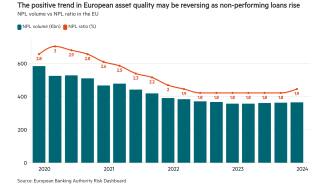At a glance
- French, Spanish, Italian and German banks have posted robust final year results
- Rising non-performing loans and credit deterioration have not materialised yet
- The gap between net interest income and interest expenses will grow
The return of interest rates to historical averages has created opportunities and challenges for European investment banks. How they weathered rising rates was revealed in their full 2023 results published in January and February.
Analysts The Banker spoke to said that the results were in line with expectations and that net interest income peaked in 2023. In the year ahead it is expected to flatline, but analysts also point out that European banks are resilient with high liquidity buffer levels from the Covid-19 pandemic.
This puts them in a strong position to navigate headwinds such as the pinch on NII, persistently high inflation and a slight deterioration in asset quality. The results also reflected the internal nuances of where the banks are based. Despite these strong results, regulators have warned against complacency. Claudia Buch, chair of the supervisory board at the European Central Bank, has said that while banks have coped with recent stresses well, they will “not be immune to risks” in the longer term.
Buch became the eurozone’s top banking supervisor on January 1 and in her first speech said: “The currently good level of profitability provides an opportunity to build buffers to cushion shocks.”
French market
According to The Banker Database, BNP Paribas has reported solid results with pre-tax profits of above $15bn for the past three years. In 2021, full-year results PTP were $15.5bn, in 2022 they were $15.3bn and in 2023 $16.3bn. The robust performance for 2023 has been helped by the sale of Bank of the West to BMO Financial Group for $3bn. The transaction completed on February 1 2023.
It also showed stable growth in assets and maintained asset quality, meaning Stage 3 loans, which are non-performing loans, made up 1.7 per cent of the gross loans in 2023 and 2022.
However, the retail arms of BNP Paribas and Société Générale were affected by the specificities of the French market, in which they cannot attain the NII growth other jurisdictions experience.
This stems from the fact that French retail banks cannot pass higher interest rates onto consumers because many have accounts with long-term fixed rates. Additionally, there is a large proportion of regulated deposits in France with already higher rates.
“You have pressure on the asset side and also pressure on the liability side, which explains why French banks are not experiencing growth [in the retail space] compared with peers elsewhere,” says Arnaud Journois, vice-president, European financial institution ratings at Morningstar DBRS.
However Journois — who looks at banks in France, Belgium, Italy and Spain — adds that a French bank with international retail operations can make this up. Another dimension that limits any profit drag from the retail side is that BNP Paribas and Société Générale have other revenue streams.
That can be seen with BNP Paribas, where Journois says French retail banking accounts for around 14 per cent of the overall revenues reported by the group for 2023.
“Overall, I would say international retail banking benefited from the rise in rates while its corporate and institutional banking performed well, even in comparison with US banks,” Journois adds.
NII was almost unchanged from $22.bn in 2022 and $21.2bn in 2023. Interest income jumped from $43.7bn to $88.4bn while interest expenses increased from $21.5bn to $67.2bn over the same period.
Yet Journois flags several factors that have clipped profit growth, such as the wind-down of targeted longer-term refinancing operations by the European Central Bank. That has been estimated to be worth $938mn, while the bank has also set aside money to compensate customers over Swiss franc mortgages and the bank levies in core markets such as Belgium.
“We have started to see the first signs of asset quality deterioration, especially exposure to commercial real estate,” he adds. “So BNP Paribas will start to experience more challenges in its real estate activities. But also we have started to see for some banks an increase in Stage 2 loans related to this. So this is an area we’ll keep monitoring throughout 2024.”
Stage 2 indicates loans where the credit risk has increased significantly since the loan was initially made.
Despite all of these factors, Journois still sees revenues exceeding costs and risks kept under control going forward.
Société Générale is going through a period of restructuring after cutting its exposure to Russia and weakness in its French retail business. Its NII fell slightly to $11.5bn in 2023 from $12bn in 2022 while its interest income increased from $30.7bn last year to $59bn in 2023.
However interest expenses also grew from $18.7bn to $47.5bn for the same period.
“You will see profits were up 25 per cent but it is because in 2022 the Russian subsidiary was written off,” says Journois. “So if you exclude all the exceptional elements between 2022 and 2023, net profits are actually down 30 per cent, reflecting lower revenues and higher operating expenses. The good news is that the cost of risk is down.”
But Société Générale faces stronger headwinds than BNP Paribas because more of its revenues are derived from retail banking in France. So it has more customers who hold regulated deposits.
Positive developments included a robust performance in the corporate investment bank and growth of international retail banking.
“The final quarter was better than the other quarters and we expect that NII will gradually catch up over the year. Operating costs were up only 3 per cent. Also we expect revenues to grow and operating expenses to fall,” Journois says.
UBS post Credit Suisse
UBS’s acquisition of Credit Suisse has resulted in a 56 per cent increase in assets, a 65 per cent increase in loans, and a 60 per cent increase in Tier 1 capital, according to The Banker Database.
This means UBS is now among the top 20 banks worldwide in terms of Tier 1 capital.
However, it has experienced a decrease in asset quality due to a significant increase in non-performing loans. This is mainly attributable to purchased credit-impaired loans rather than Stage 3 loans, which remained steady from 2022.
Additionally, the bank recorded a 211 per cent increase in pre-tax profits, primarily due to a negative goodwill of $28.9bn resulting from the acquisition of Credit Suisse last summer. Without the negative goodwill, the bank would have recorded PTP of slightly less than $1bn.
While the operating revenue has increased by 18 per cent compared with 2022, the costs related to impairment, personnel and administrative costs have seen a significant increase of 3475 per cent.
So the total impairment charges and provisions went from $29mn in 2022 to more than $1bn in 2023.
Vitaline Yeterian, senior vice-president, global financial institutions at Morningstar DBRS, says: “UBS’s quarterly performance is demonstrating resiliency. However, integration-related costs and the non-core and legacy division will continue to weigh on returns, and it will take time before we see any synergies from the restructuring of the combined businesses.”
Germany and Spain
Regarding Deutsche Bank’s results, Sonja Foster, vice-president, European financial institution ratings at Morningstar DBRS, says: “It has turned a corner and become more stable. But in terms of profitability it lags peers, and this is the area Deutsche Bank is currently working on. So the bank has taken a number of measures to further improve earnings.
“The only thing is, as these measures are taken, there are new restructuring charges, and new one-off costs. So earnings are still not very clean. And this is something the bank is aware of. It can make it hard to see the underlying trend of improvements.”
Deutsche Bank’s NII in 2022 was $14.5bn and $15.1bn in 2023 while interest income went from $25.9bn to $49bn over the same period. Interest expenses increased from $11.3bn to $33.9bn over the year.
Banco Santander’s asset growth is stable and in line with the previous years, as are Stage 3 loans, at just above 3 per cent. PTP increased by 8 per cent (in the local currency), and are the highest recorded in the past 10 years.
The bank also had a successful performance in Europe, particularly in Spain.
Morningstar’s Journois says: “The main driver has been higher interest rates, which really boosted profits in Europe, and especially Spain. There the vast majority of loans are at variable rates so the bank can pass on higher interest rates to customers. Deposit rates, although climbing now, were quite low compared with the yield so that explains the performance the bank had in Spain.”
However, Banco Santander recorded a decline in net profits in the US and Brazil.
“In Brazil, I would say profits were down despite loan growth, which is traditionally what you see in South America or emerging markets,” says Journois. “And the main factor was really inflation that weighed on wages and therefore on operating expenses. And you also had a higher cost of risk overall.
“These are the reasons why results were down. Net interest income grew 2 per cent, far below what you would expect for the subsidiary in Brazil.”
Journois attributes the weaker performance in the US to a more subdued car loan sector and the Federal Deposit Insurance Corporation charge to replenish the fund dealing with bank failures.
Italian lenders
Italy’s two largest banks, UniCredit and Intesa Sanpaolo, published strong results, while Monte dei Paschi di Siena distributed its first dividend in 13 years, demonstrating a change in the long struggling bank's fortunes.
According to Andrea Costanzo, vice-president, European financial institution ratings at Morningstar DBRS, there were three drivers of their strong results: robust NII, lower loss provisions compared with historical levels and resilient fee income despite a difficult economic climate.
One feature shared by UniCredit and Intesa Sanpaolo is their reduced exposures to Russia.
“When we look at the largest Italian banks, the progress has been material,” says Costanzo. “Banks have made progress in reducing costs and overall their asset quality is sound.
“On funding and liquidity trends, at the start of year we saw deposit outflows from the banks but in the second half of the year banks managed to absorb some of these outflows by offering the new BTP government bonds to retail clients. Banks can still earn fees and commission on the placement of these products. Overall the starting point for this year is very good for the banks.”













